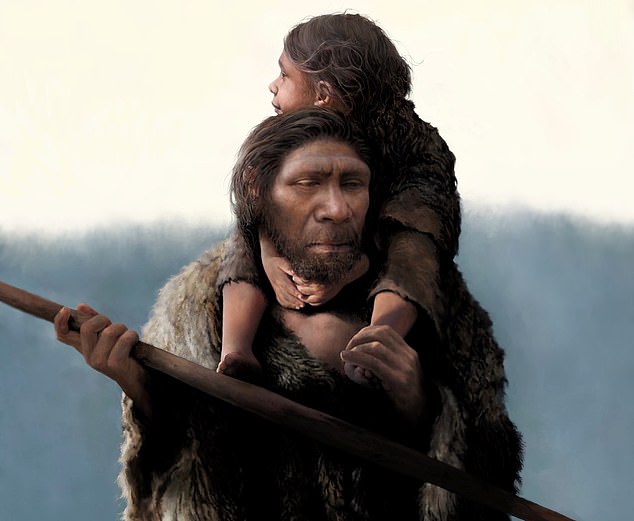First case of Down syndrome among Neanderthals discovered in six-year-old child who lived more than 145,000 years ago
Scientists claimed to have discovered the first case of Down syndrome in Neanderthals, suggesting that the archaic humans were compassionate caregivers.
The team analyzed a small skull fragment from a six-year-old child they named “Tina,” who lived more than 1,450,000 years ago, and found that the fossil had features consistent among children with the genetic condition.
The analysis showed that Tina suffered from a congenital defect in the inner ear, which was related to the genetic defect. This abnormality led to severe hearing loss and disabling dizziness.
The discovery has suggested that Neanderthals were able to provide altruistic care and support to a vulnerable member of their social group, as the child survived for years after birth.
The team made digital scans of a small skull fragment of a six-year-old child they named ‘Tina’, which was uncovered in Cova Negra, a cave in Spain.
Dr. Mercedes Conde-Valverde, professor at the University of Alcalá and lead author of the study, told DailyMail.com: ‘Until now it was only possible to diagnose Down syndrome in fossil specimens through the analysis of ancient DNA.
‘In our work we were able to make the diagnosis through an anatomical study of the inner ear.
‘This opens the possibility to study the potential presence of Down syndrome in fossil specimens and thus document its prevalence in past populations.’
Cova Negra is a cave site in Valencia that was excavated between 1929 and 2017, revealing fossilized remains of Neanderthals who lived between 273,000 and 146,000 years ago.
Researchers analyzed remains found during a 1989 dig and uncovered three new fossils that had previously been overlooked.
Among the trio was “an immature temporal bone (CN-46700),” the team wrote in the study published in Scientific progress.

The digital scan of CN-46700 showed an abnormally reduced volume in the cochlea, a hollow tube in the inner ear that looks like a coiled snail shell and contains the sense of hearing
It was a fragment of one of the two temporal bones – the right one – that help form the sides and base of the skull, protect the brain and surround the ear canal.
Researchers used micro-computed tomography on the fossil, a 3D imaging technique that uses X-rays to look inside an object piece by piece.
The digital scan of CN-46700 showed that a combination of inner ear abnormalities is only known in people with Down syndrome.
“The pathology from which this person suffered resulted in highly disabling symptoms, including at the very least complete deafness, severe attacks of vertigo and an inability to maintain balance,” said Dr. Conde-Valverde.
CN-46700 showed abnormally reduced volume in the cochlea, a hollow tube in the inner ear that resembles a coiled cochlea and contains the hearing organ.
This suggested that the cavity was much narrower than average, which occurs in up to 50 percent of children with Down syndrome.
The scan was compared to another digital Neanderthal ear from a child of about the same age, and showed a difference from Tina’s.
The scan was compared to another digital Neanderthal ear from a child of about the same age, and showed a difference from Tina’s.
Other symptoms CN-46700 experienced “would include, at a minimum, severe hearing loss and a significantly reduced sense of balance and equilibrium,” Conde-Valverde and her team wrote.
The team also discovered malformations in the lateral semicircular canal, which previous research has shown to be common in people with Down syndrome.
The lateral semicircular canal is the shortest of the three ear canals, which senses rotational and angular movements of the head.

Researchers say the discovery suggests that Neanderthals were able to provide altruistic care and support to a vulnerable member of their social group as the child survived for years after birth.
A 2014 study conducted by the University of Montreal that analyzed 34 years of subjects with Down syndrome found that 5.8 percent had two cases of lateral semicircular canal deformity.
The fossilized ear canal also showed enlarged vestibular aqueducts, previously discovered in individuals with the genetic condition.
The team noted that when the fossils were found in 1929, the average life expectancy for a child with Down syndrome was only nine years.
And previous research has shown earlier cases during the Iron Age, but the three known examples have not survived the past 16 months.
Because Tina lived until the age of six, this indicated that she was cared for by other members of her group.
‘What was not known until now was any case of an individual receiving help even though they could not return the favor, which would prove the existence of true altruism among Neanderthals, said Dr. Conde- Valverde in a statement.
“That’s exactly what the discovery of ‘Tina’ means.”
